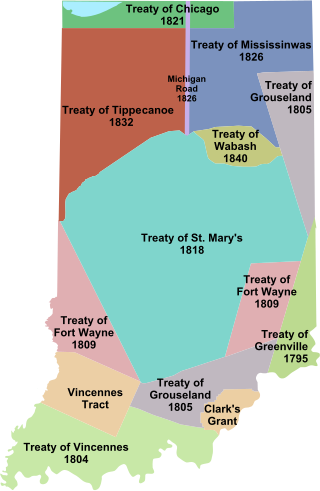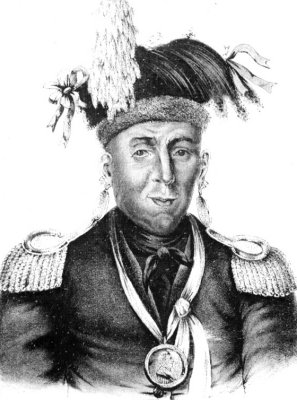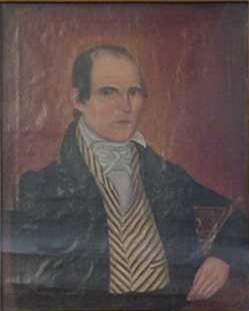Stone Eater (Sanemamitch) was a Wea war chief in the 18th century, after the abandonment of Ouiantanon, in the present day U.S. state Indiana.
Stone Eater (a contemporary of P'koum-kwa, aka "Pacanne") joined the Tecumseh confederacy, and with Winamac and White Loon, led Native American forces at the Battle of Tippecanoe in 1811. [1] [2] He also led warriors at the 1812 Siege of Fort Harrison, [3] and was an active participant in the War of 1812. Under the name Newa Shosa, he signed the armistice concluded in Detroit on October 14, 1813. On October 2, 1818, probably he signed, under the name Shamana, also the St. Mary's Treaty after Jacco's signature. Stone Eater was killed by another Wea warrior in 1822. [4]

The Battle of Tippecanoe was fought on November 7, 1811, in Battle Ground, Indiana, between American forces led by then Governor William Henry Harrison of the Indiana Territory and tribal forces associated with Shawnee leader Tecumseh and his brother Tenskwatawa, leaders of a confederacy of various tribes who opposed European-American settlement of the American frontier. As tensions and violence increased, Governor Harrison marched with an army of about 1,000 men to attack the confederacy's headquarters at Prophetstown, near the confluence of the Tippecanoe River and the Wabash River.

The Miami are a Native American nation originally speaking one of the Algonquian languages. Among the peoples known as the Great Lakes tribes, they occupied territory that is now identified as north-central Indiana, southwest Michigan, and western Ohio. The Miami were historically made up of several prominent subgroups, including the Piankeshaw, Wea, Pepikokia, Kilatika, Mengakonkia, and Atchakangouen. In modern times, Miami is used more specifically to refer to the Atchakangouen. By 1846, most of the Miami had been forcefully displaced to Indian Territory. The Miami Tribe of Oklahoma are the federally recognized tribe of Miami Indians in the United States. The Miami Nation of Indiana, a nonprofit organization of self-identified descendants of Miamis who were exempted from removal, have unsuccessfully sought separate recognition.

Tecumseh was a Shawnee chief and warrior who promoted resistance to the expansion of the United States onto Native American lands. A persuasive orator, Tecumseh traveled widely, forming a Native American confederacy and promoting intertribal unity. Even though his efforts to unite Native Americans ended with his death in the War of 1812, he became an iconic folk hero in American, Indigenous, and Canadian popular history.

The Treaty of Greenville, also known to Americans as the Treaty with the Wyandots, etc., but formally titled A treaty of peace between the United States of America, and the tribes of Indians called the Wyandots, Delawares, Shawanees, Ottawas, Chippewas, Pattawatimas, Miamis, Eel Rivers, Weas, Kickapoos, Piankeshaws, and Kaskaskias was a 1795 treaty between the United States and indigenous nations of the Northwest Territory, including the Wyandot and Delaware peoples, that redefined the boundary between indigenous peoples' lands and territory for European American community settlement.

Tecumseh's War or Tecumseh's Rebellion was a conflict between the United States and Tecumseh's confederacy, led by the Shawnee leader Tecumseh in the Indiana Territory. Although the war is often considered to have climaxed with William Henry Harrison's victory at the Battle of Tippecanoe in 1811, Tecumseh's War essentially continued into the War of 1812 and is frequently considered a part of that larger struggle. The war lasted for two more years, until 1813, when Tecumseh and his second-in-command, Roundhead, died fighting Harrison's Army of the Northwest at the Battle of Moraviantown in Upper Canada, near present-day Chatham, Ontario, and his confederacy disintegrated. Tecumseh's War is viewed by some academic historians as the final conflict of a longer-term military struggle for control of the Great Lakes region of North America, encompassing a number of wars over several generations, referred to as the Sixty Years' War.

Tenskwatawa was a Native American religious and political leader of the Shawnee tribe, known as the Prophet or the Shawnee Prophet. He was a younger brother of Tecumseh, a leader of the Shawnee. In his early years Tenskwatawa was given the name Lalawethika, but he changed it around 1805 and transformed himself from a hapless, alcoholic youth into an influential spiritual leader. Tenskwatawa denounced the Americans, calling them the offspring of the Evil Spirit, and led a purification movement that promoted unity among the Indigenous peoples of North America, rejected acculturation to the American way of life, and encouraged his followers to pursue traditional ways.

Fort Harrison was a War of 1812 era stockade constructed in Oct. 1811 on high ground overlooking the Wabash River on a portion of what is today the modern city of Terre Haute, Indiana, by forces under command of Gen. William Henry Harrison. It was a staging point for Harrison to encamp his forces just prior to the Battle of Tippecanoe a month later. The fort was the site of a famous battle in the War of 1812, the siege of Fort Harrison in Sept. 1812 that was the first significant victory for the U.S. in the war. The fort was abandoned in 1818 as the frontier moved westward.

William Wells, also known as Apekonit, was the son-in-law of Chief Little Turtle of the Miami. He fought for the Miami in the Northwest Indian War. During the course of that war, he became a United States Army officer, and also served in the War of 1812.

The Treaty of Fort Wayne, sometimes called the Ten O'clock Line Treaty or the Twelve Mile Line Treaty, is an 1809 treaty that obtained 29,719,530 acres of Native American land for the settlers of Illinois and Indiana. The negotiations primarily involved the Delaware tribe but included other tribes as well. However, the negotiations excluded the Shawnee, who were minor inhabitants of the area and had previously been asked to leave by Miami War Chief Little Turtle. Territorial Governor William Henry Harrison negotiated the treaty with the tribes. The treaty led to a war with the United States begun by Shawnee leader Tecumseh and other dissenting tribesmen in what came to be called "Tecumseh's War".

John Tipton was from Tennessee and became a farmer in Indiana; an officer in the 1811 Battle of Tippecanoe, and veteran officer of the War of 1812, in which he reached the rank of Brigadier General; and politician. He was elected to the Indiana General Assembly in 1819, and in 1831 as US Senator from the state of Indiana, serving until 1838. He was appointed as US Indian Agent and was selected to lead the militia in removing Menominee's band of Potawatomie in 1838; they were relocated to Kansas, Indian Territory.

During the 18th and early 19th centuries, the French, British and U.S. forces built and occupied a number of forts at Vincennes, Indiana. These outposts commanded a strategic position on the Wabash River. The names of the installations were changed by the various ruling parties, and the forts were considered strategic in the French and Indian War, the American Revolutionary War, the Northwest Indian War and the War of 1812. The last fort was abandoned in 1816.
Winamac was the name of a number of Potawatomi leaders and warriors beginning in the late 17th century. The name derives from a man named Wilamet, a Native American from an eastern tribe who in 1681 was appointed to serve as a liaison between New France and the natives of the Lake Michigan region. Wilamet was adopted by the Potawatomis, and his name, which meant "Catfish" in his native Eastern Algonquian language, was soon transformed into "Winamac", which means the same thing in the Potawatomi language. The Potawatomi version of the name has been spelled in a variety of ways, including Winnemac, Winamek, and Winnemeg.

Waubonsie was a leader of the Potawatomi Native American people. His name has been spelled in a variety of ways, including Wabaunsee, Wah-bahn-se, Waubonsee, Waabaanizii in the contemporary Ojibwe language, and Wabanzi in the contemporary Potawatomi language.

Joseph Bartholomew was a general in the Indiana Militia and served in numerous military conflicts. He also worked as a farmer, hunter, trapper, self-taught surveyor, and politician. Bartholomew County, Indiana and the Bartholomew Trail were named after him.

During the War of 1812, the Indiana Territory was the scene of numerous engagements which occurred as part of the conflict's western theater. Prior to the war's outbreak in 1812, settlers from the United States had been gradually colonizing the region, which led to increased tensions with local Native Americans and the outbreak of Tecumseh's War. In 1811, Tecumseh's confederacy, formed in response to encroachment by white American settlers, was defeated by U.S. forces at the Battle of Tippecanoe. After the conflict broke out, most Native Americans in the region joined forces with the British Empire and attacked American forces and settlers in concert with their British allies.

Tecumseh's confederacy was a confederation of Native Americans in the Great Lakes region of North America which formed during the early 19th century around the teaching of Shawnee leader Tenskwatawa. The confederation grew over several years and came to include several thousand Native American warriors. Shawnee leader Tecumseh, the brother of Tenskwatawa, became the leader of the confederation as early as 1808. Together, they worked to unite the various tribes against colonizers from the United States who had been crossing the Appalachian Mountains and occupying their traditional homelands.
The following units of the U.S. Army and state militia forces under Indiana Governor William Henry Harrison, fought against the Native American warriors of Tecumseh's Confederacy, led by Chief Tecumseh's brother, Tenskwatawa "The Prophet" at the battle of Tippecanoe on November 7, 1811.

The Battle of Wild Cat Creek was the result of a November 1812 punitive expedition against Native American villages during the War of 1812. It has been nicknamed "Spur's Defeat", which is thought to refer to the spurs used by the soldiers to drive their horses away from the battle as quickly as possible. The campaign is sometimes referred to as the Second Battle of Tippecanoe.
White Loon, Michikinikwa's son-in law, was a Miami leader during Tecumseh's War and the War of 1812. He may also have been active in raids against the United States in years following the 1791 St. Clair's Defeat, repeatedly fighting against General "Mad" Anthony Wayne's troops, and, as "Wapamangwa", he signed the Greenville Treaty on August 3, 1795. He led warriors at the Battle of Tippecanoe, along with Wea chief Stone Eater and Potawatomi chief Winamac.
The Western theater of the War of 1812 was a theater of war during the War of 1812 between the United States and the United Kingdom. Far from the Atlantic Coast and large cities, logistics and communication were more challenging in the western territories and the United States frontier. For many Native American nations involved, this war was a continuation of the defense of their lands against encroaching settlers.